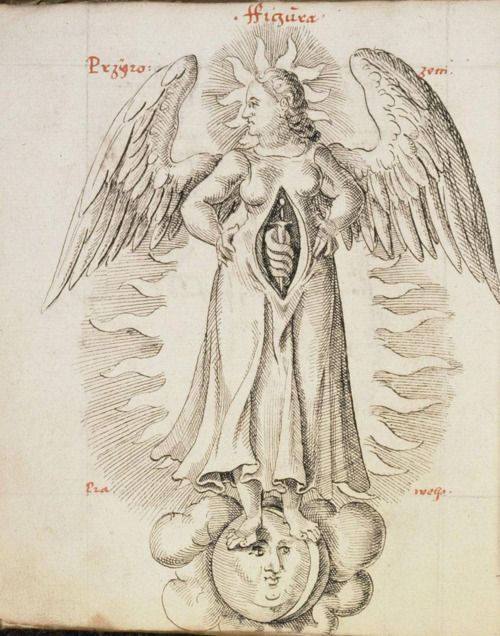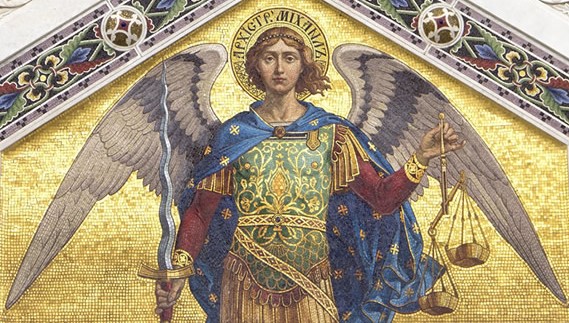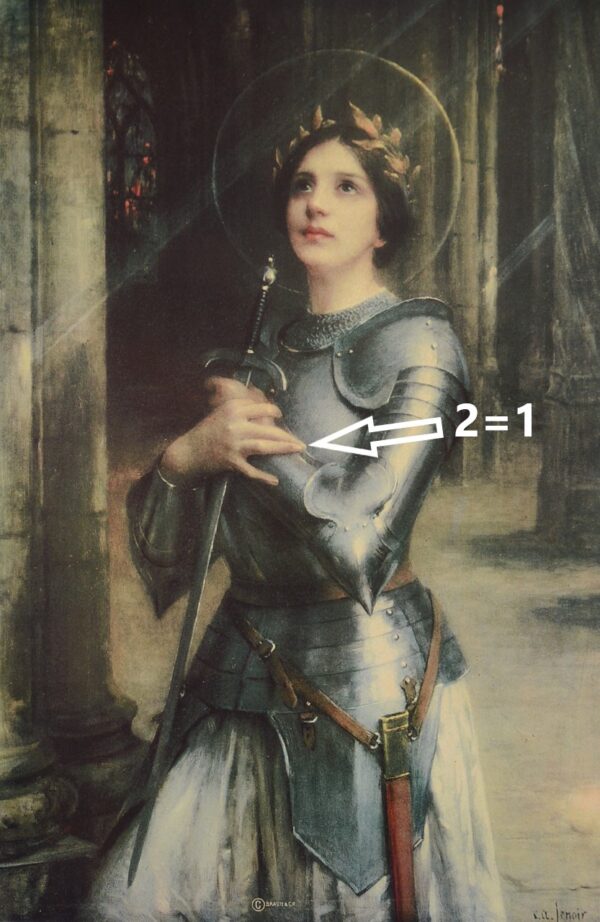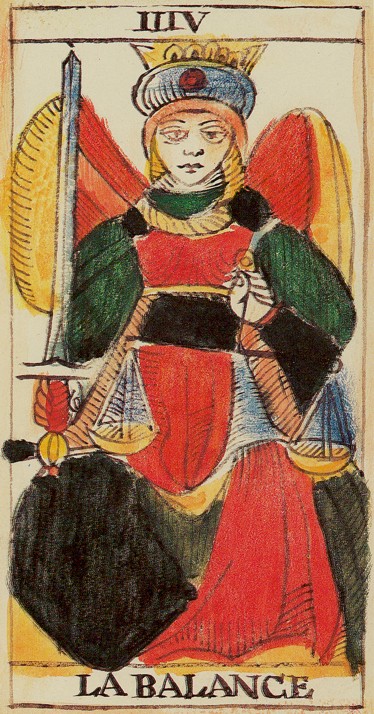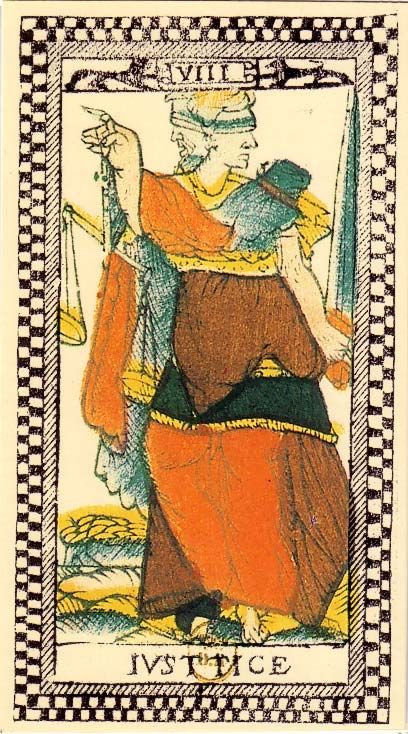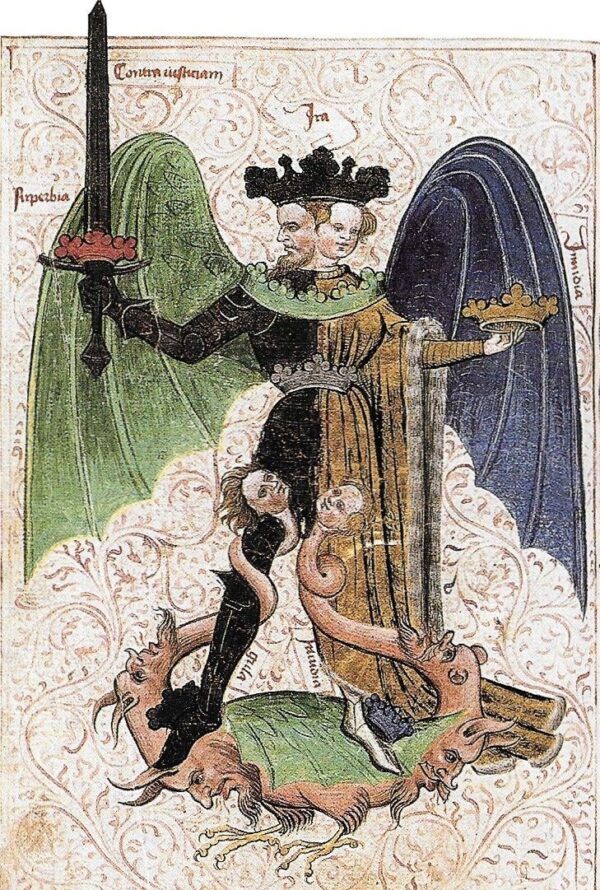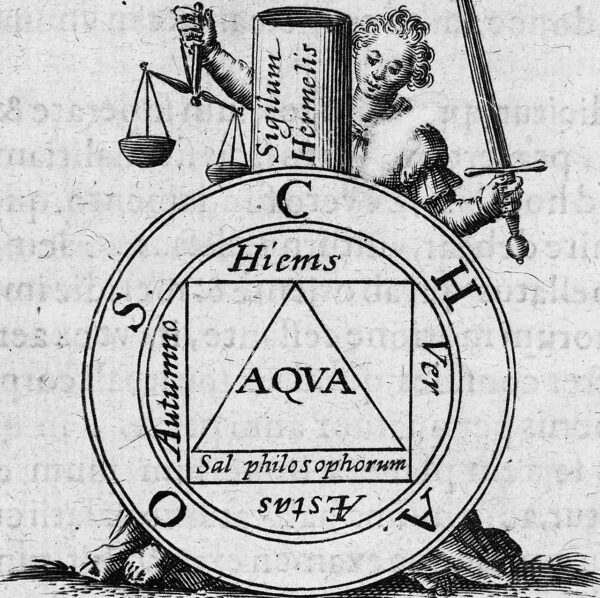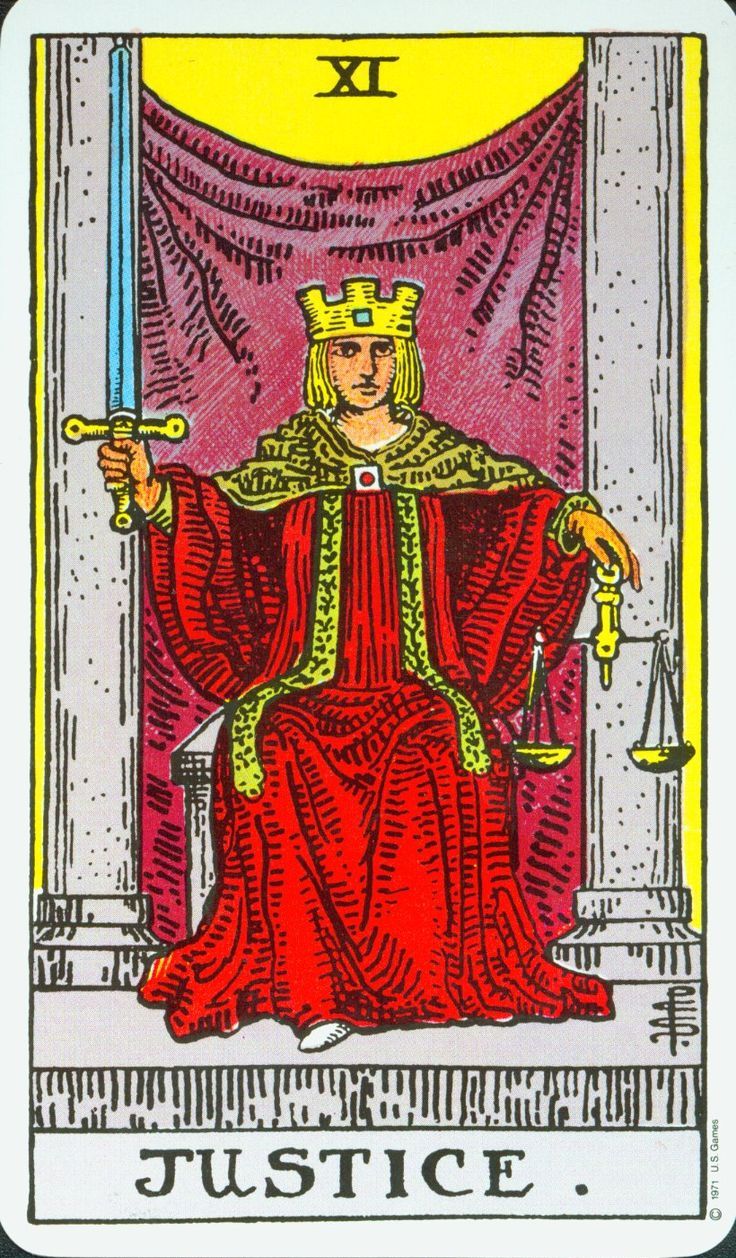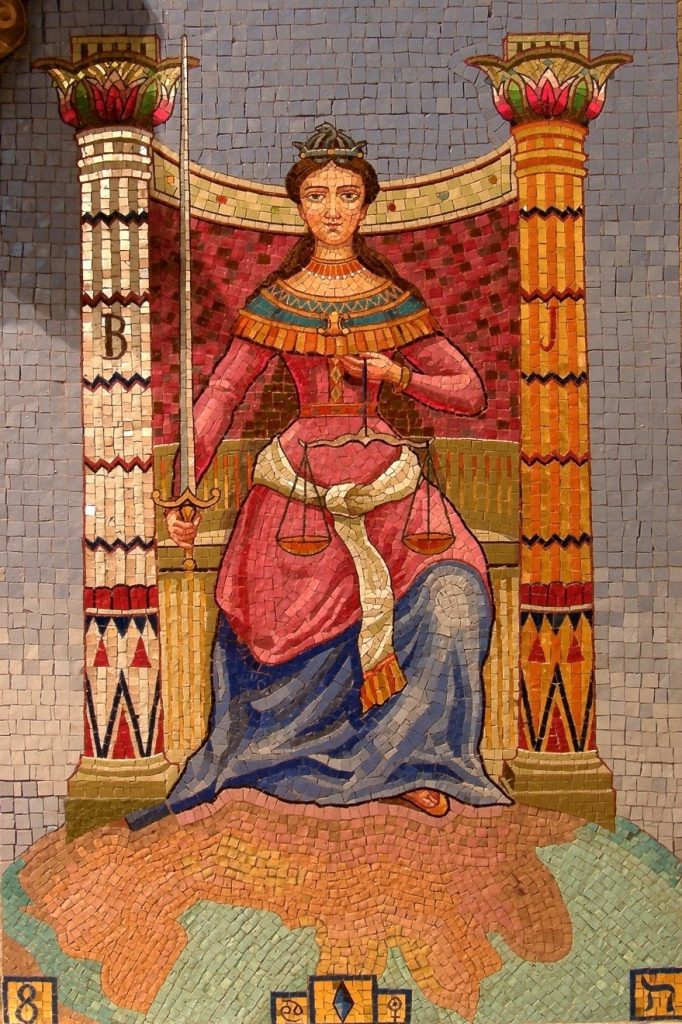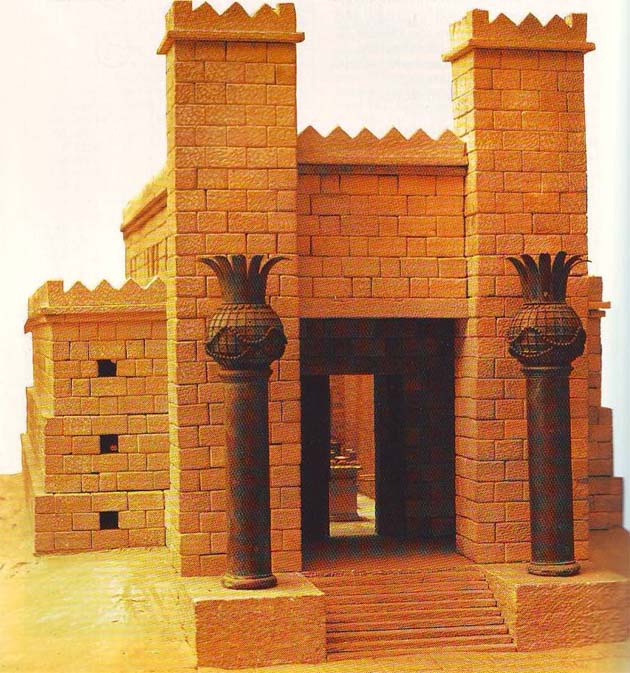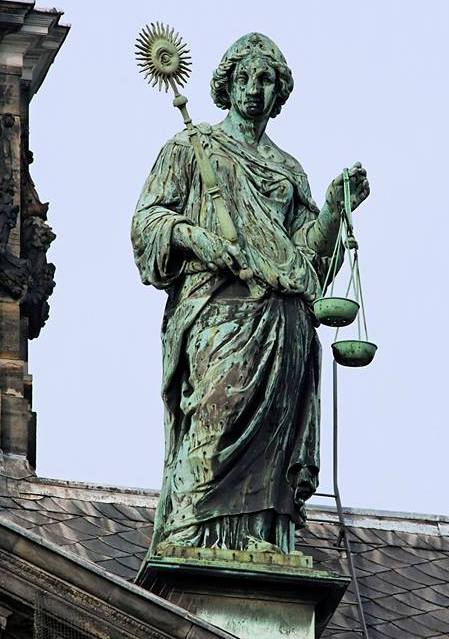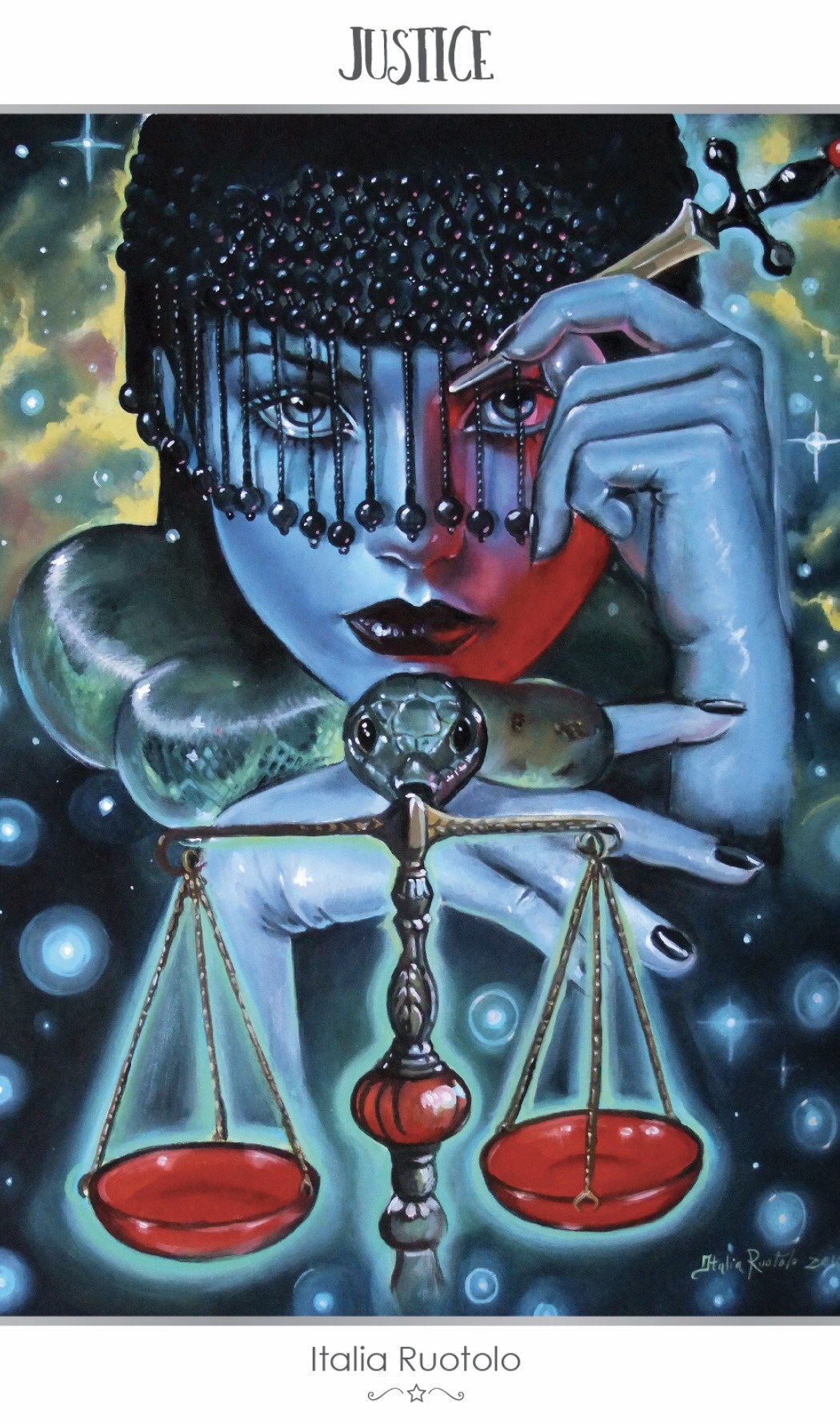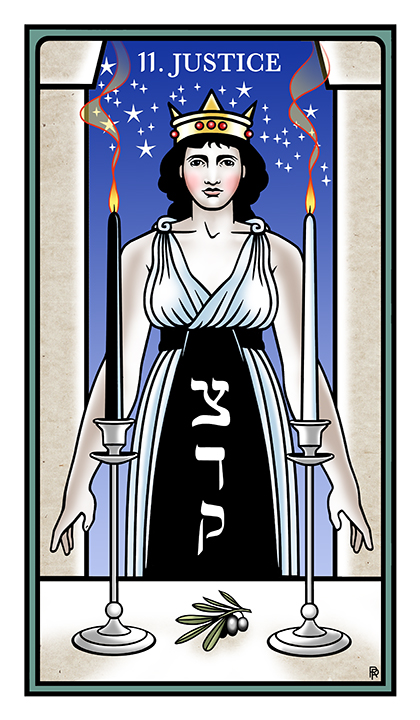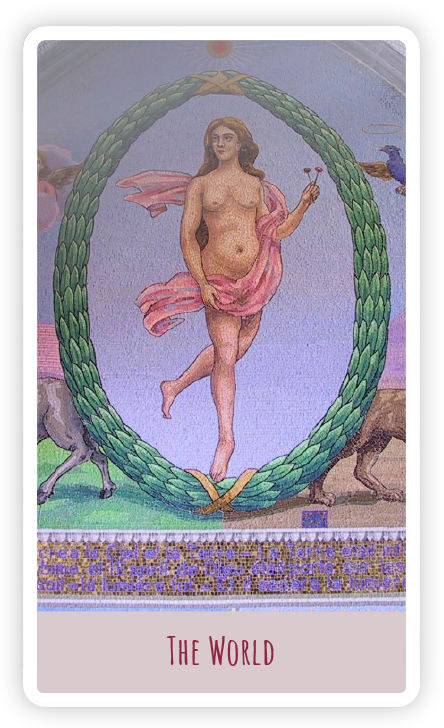8. Justice
It is a familiar image in court buildings: Lady Justice, the personification of the law; a stern looking woman with a sword and scales. Her Greek origin is the goddess Themis, whose task it was to guard the divine order and laws. This divine order made it possible for the gods and people to live together. Themis’ scales stood for inner balance. The tarot card Justice is also about inner balance; an important prerequisite for spiritual awakening.
Justice is one of the four so-called cardinal virtues. She owes her place in the tarot to this. The four virtues of prudentia (prudence, wisdom), justitia (justice), fortitudo (courage, strength) and temperantia (moderation, self-control) are considered extra important in Christianity, because other virtues rely on it (cardinal means “pivotal”, based on the Latin cardo: hinge).
Noteworthy, is that the cardinal virtues, both in and outside the tarot, are almost always personified by women. The reason for this can be found in the book of Wisdom from the Old Testament. In this book these four virtues are mentioned as the result of the divine “Wisdom” (Greek: Sophia), which underlies creation:
…her [Wisdom] labours have great virtues: for she teacheth temperance, and prudence, and justice, and fortitude, which are such things as men can have nothing more profitable in life.
(Wisdom 8:7)
Sophia (Wisdom) is one of the names of God the Mother; the feminine aspect of God, which is found in the human pelvis as well as in all of creation. The yogi calls her the kundalini-shakti. This is – of course – not how the church explains Sophia, but this meaning can be inferred from the Bible texts if they are read with esoteric glasses. Another quote from the Book of Wisdom:
For wisdom [Sophia] is more mobile than any motion; because of her pureness she pervades and penetrates all things. For she is a breath of the power of God, and a pure emanation of the glory of the Almighty; therefore nothing defiled gains entrance into her. For she is a reflection of eternal light, a spotless mirror of the working of God, and an image of his goodness. Though she is but one, she can do all things, and while remaining in herself, she renews all things; in every generation she passes into holy souls and makes them friends of God, and prophets…
(Wisdom 7: 24-27)
We find Sophia – disguised – on many tarot cards. Not only as a personification of the cardinal virtues, but also as, for instance, the High Priestess.
The Visconti-Sforza Tarot
The Justice card from the 15th century Visconti-Sforza deck (below left)seems straightforward in meaning. But this is misleading; the card does contain subtle esoteric symbolism!
The Damsel of Swords card of the 15th century Visconti di Modrone deck. A pomegranate pattern is printed on her dress. The POMEGRANATE (click here) is a symbol for the kundalini energy.
Before the sacred marriage can take place at the sixth chakra, the first five chakras must be purified, and the two energy channels that flow along the spine – and that form the energetic blueprint of duality in man – must be balanced. This is what the Justice card stands for. The sword symbolizes the purifying effect of the kundalini (Sophia) and the scales represent the energetic balance.
The symbolic meaning of a sword, with regard to spiritual awakening, is confirmed by other 15th century tarot cards. On both cards above (center and right) the woman makes the (secret) sign of the sacred marriage (two fingers together: 2=1): the inner polarity has merged to oneness as a result of the activity of the sword / kundalini.
Right: an alchemical emblem with the essence of the spiritual process of awakening. The hands pointing up and down make the SIGN OF THE SACRED MARRIAGE (2=1). In order to connect the sun (God) and the earth (man), the kundalini energy (the sun in the center) must purify man (SWORD) and balance the polar energies (SCALES). (Andreas Friedrichen, Emblemata Nova, 1617)
The woman on the Visconti Justice card is wearing a dress with hexagons. This is a reference to the hexagram (six-pointed star); the universal symbol for the merger of the polarities (right). With the hand with which the woman holds the scales, she is, subtly, making the sign of the sacred marriage. The scales have different colors: gold and silver. This is a reference to the polar energies – sun (gold) and moon (silver) – that have been balanced.
Confirmation of this interpretation can be found, for example, on the exterior facade of New Suffolk County Court House in the USA (below). Two serpents coil around Lady Justice’s scales: a reference to the caduceus, the symbol for a kundalini awakening. The serpents of the caduceus represent the polar energy channels.
On the upper half of the Visconti-Sforza card we see a woman in armor, riding a white horse, and holding a raised sword. This is a metaphor for the purifying effect of Sophia / the kundalini-shakti in action. A white horse stands for purified animal drives. Both the woman’s armor and the metal plate on the horse’s head are made of one half of gold and one half of silver. The horse’s deck is decorated with five-petalled flowers: the Rose of Venus, an ancient kundalini symbol (right).
Right: an alchemical depiction of the Magnum Opus. The alchemist is covered with the Rose of Venus/kundalini energy.
Undoubtedly, this image of a combative woman on a horse was inspired by the French Jeanne ‘d Arc, who was executed some twenty years before the appearance of this tarot deck (below right).
The Archangel Michael (below left) is also often depicted with a sword and scales. The symbolic meaning is the same as what the tarot card Justice wants to convey. The angel Michael represents the divine (kundalini) energy in our pelvis that, once awakened, goes to war against our inner demons, and balances our polar energies.
Read more about the symbolism in de Bible in my book ‘John the Baptist who became Jesus the Christ’.
Mosaic of Saint Michael on the facade of the Serbian Orthodox Church in Trieste.
Right: Joan of Arc, Charles Amable Lenoir, circa 1900. With the sign of the sacred marriage (2=1) the artist suggests that Joan of Arc has experienced a kundalini awakening.
The Tarot of Marseille
The Tarot of Marseille is a collective name for tarot decks that have been designed and produced by different people, in a specific period, in a specific geographical area. The various versions are similar in style and are easily recognizable as ‘Marseille decks’. For the tarot researcher, the differences between the decks are particularly interesting.
That the woman on the card is Sophia / the kundalini-shakti can be deduced from her multicolored dress. At the time, printing was still in its infancy. With the limited color spectrum that the designers had available, they tried to incorporate all chakra colors into the dress.
The braided necklace refers to the two polar energy channels that merge during a kundalini awakening. The woman’s curly hair strands represent the same. On both cards one lock of hair touches the necklace, to indicate that they have the same meaning.

We also see this symbolic hairstyle in Orthodox (Hasidic) Judaism. The men wear curled strands of hair on both sides of the head. These so-called peies grow at the height of the temples, the place where the two energy channels merge during the sacred marriage.
The jewel on the front of the crown refers to the pineal gland, which is activated during a kundalini awakening. On the Payen Webb card, the woman has wings to emphasize her divinity. On the card of Pierre Madenié she sits between two pillars. These represent the two polar energy channels.
Left: in esoteric traditions, the three energy channels involved in a kundalini awakening are often represented by pillars.
The designer of the Payen-Webb deck has given the card a different name: La Balance (Balance).
This reinforces the esoteric meaning of inner balance.
The Tarot of Paris (right) takes a slightly different approach, making the symbolic meaning of the Justice card even clearer. The figure has a head with a masculine and feminine face; a reference to the androgyn ‘Rebis’ from alchemy (far right), in which the polar energies are balanced and merged.
Not only in the tarot, but also in other art forms, as Christian paintings en sculptures, artists attempted to communicate knowledge on the spiritual process of awakening, that went against the teachings of the church. These are three examples of kundalini symbolism on engravings of the cardinal virtue Justice.
From left to right:
1. The woman holds her sword in the middle of the scales, creating the symbolism of three energy channels (1593).
2. The woman sticks out the MIDDLE FINGER (click here) of her left hand. The middle finger represents the awakened spine, in esoteric symbolism (Jacob Matham, 17th century).
3. The woman holds the scales in front of a PILLAR (click here), creating the symbolism of three energy channels. Depicting just ONE LEG (click here) symbolizes the merger of the polar energies (Lucas van Leyden, 1530, Rijksmuseum).
Oswald Wirth and Rider-Waite-Smith
The occultists of the Golden Dawn, Oswald Wirth and Arthur Waite, have not added many new elements to the card. Arthur Waite has swapped the cards Justice and Strenght: Justice has number 11 on his deck. The crown on the card of both Wirth and Waite has three points; a reference to the three energy channels that are involved in a kundalini awakening.
On both cards, the woman has on her chest the symbol of a circle within a square. This is a reference to ‘squaring the circle’ from alchemy: a metaphor for the Magnum Opus (process of God-realization). See illustration below.
The Seventh of the Twelve Keys of Basil Valentine.
The two ribbons on the mantle on the RWS card have the same meaning as the two pillars: the polar energies. The letter Y on these ribbons symbolizes in alchemy the fusion of the opposites (see RWS card 5 The Hierophant). The androgynous appearance of the RWS woman, as well as the visibility of only one shoe, also refers to this. She holds her sword and scales right in front of the two pillars: she (Sophia/the kundalini) purifies and balances these two pillars / energy channels.
The handle of her sword displays the symbol for gold (a circle with a dot in the middle): a reference to the divine energy that this sword represents. Like on tarot card number 2 The High Priestess, the curtain between the pillars is the veil of Isis, behind which the Greater Reality is hiden.
Château des Avenières
On the mosaic in the chapel of Château des Avenières the two pillars are marked with the letters B and J. An element we know from the High Priestess card of the RWS deck. These letters stand for Boaz and Jachin: the names of the bronze columns at the entrance of King Solomon’s temple. According to the Old Testament, this entrance leads to the Arc of the Covenant in the Holy of Holies, where man can communicate with God.
The temple represents man himself, the pillars are the polar energy channels on both sides of the spine, and the entrance is located on the bottom the spine, in the pelvis. The Arc of the Covenant is in the head of man: the pineal gland and pituitary gland are activated by the risen kundalini (Sophia).
Read more about the symbolism in de Bible in my book ‘John the Baptist who became Jesus the Christ’.
A uraeus-cobra is placed on the woman’s small crown: the serpent that symbolized the kundalini in ancient Egypt, and with which pharaohs were often depicted.
Conclusion
The tarot uses well-known archetypes to translate these into aspects of spiritual awakening. The Justice card shows Sophia in her role of divine Mother. Everything that stands between us and her husband, God the Father, she removes with her sword. Not always painless, but with good intentions and love, like a real mother. Our interior is purified and balanced by her.
These spiritual tasks are similar to the role of Lady Justice (the Judiciary) in the outside world: “cleansing” society of what disrupts harmony, and imposing punishments proportional to the offenses committed, to restore balance.
Right: a statue of the cardinal virtue Justice on the roof of the Palace on the Dam in Amsterdam, the Netherlands (sculptor Artus Quellinus, 17th century). This statue also displays esoteric symbolism. Instead of a sword, the woman holds a SCEPTER (symbol of the spine, click here) with a sun at the top, and the all-seeing Eye of God. The scepter is placed on her PELVIS, at the height of the sacrum, the abode of the kundalini, and the Eye of God is at the height of the PINEAL GLAND.
78 Tarot Astral
(2017)
www.78tarot.cards
A beautiful card with the kundalini serpent holding the scales. The tip of the sword is placed between the eyes, aimed at the pineal gland.
Cosmic Tarot
(Norbert Lösche, 1988)
Lady Justice as ‘the middle pillar’.
The Star Tarot
(Cathy McClelland, 2017) www.cathymcclelland.com
Several universal kundalini symbols have been combined in a relevant, creative way: three trees, running water, the eclipse (union of sun and moon), peacock feathers, and the forehead as the spot where the polarities merge.
The Raziel Tarot
(Robert M. Place, 2016)
www.robertmplacetarot.com
In mystical Judaism, the Shekinah (the woman between the pillars) is the indwelling divine, or Sophia / the kundalini-shakti.
This artikel was published in Paravisie Magazine (sept ’19). Copyright Anne-Marie Wegh 2019
Anne-Marie Wegh is the author of the book
John the Baptist who became Jesus the Christ

Illustrations from the tarot decks, reproduced by permission of U.S. Games Systems, Inc., Stamford, CT 06902. c. by U.S. Games Systems, Inc. All rights reserved.
Foto’s Châteaux de Avenières: http://hermetism.free.fr/Avenieres








